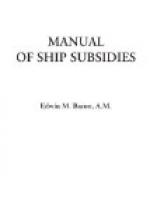Cromwell’s code, of which the act of 1381 was the germ, was established the next year, 1651. Its primary object was to check the maritime supremacy of Holland, then attaining dominance of the sea; and to strike a decisive blow at her naval power. The ultimate aim was to secure to England the whole carrying trade of the world, Europe only excepted.[H] These were its chief provisions: that no goods or commodities whatever of the growth, production, or manufacture of Asia, Africa, or America should be imported either into England or Ireland, or any of the plantations, except in English-built ships, owned by English subjects, navigated by English masters, and of which three-fourths of the crew were Englishmen; or in such ships as were the real property of the people of the country or place in which the goods were produced, or from which they could only be, or most usually were, exported.[I] This last clause was the blow direct to Holland, for the Dutch had little native products to export, and their ships were mainly employed in carrying the produce of other countries to all foreign markets. It was answered with war, the fierce naval war of 1652-1654, in which was exhibited that famous spectacle of the at first victorious Dutch admiral, Van Tromp, sweeping the English Channel with a broom at his masthead.
With the final defeat of the Dutch after hard fighting on both sides, their virtual submission to the English Navigation Act, and their admission of the English “sovereignty of the seas,"[J] by their consent to “strike their flag to the shipping of the Commonwealth,” England, in her turn, became the chief sea power of the world.[K] During the ten years of peace that followed, however, the Dutch despite the English Navigation Act, succeeded in increasing their shipping, and regained much of the carrying trade if not their lost leadership.[L]
Cromwell’s act was confirmed by Charles II in 1660, and made the basis of the code which then her statesmen exalted as “The Great Maritime Charter of England.”
Early in Charles II’s reign also (in 1662) indirect bounties were offered for the encouragement of the building of larger and more efficient ships for service in time of war. These were grants of one-tenth of the customs dues on the cargo, for two years, to every vessel having two and one-half or three decks, and carrying thirty guns.[M] Thirty years later (1694), in William and Mary’s reign, the time was extended to three years. Under William and Mary the granting of bounties on naval stores was begun, and this system was continued till George III’s time.[M] With William and Mary’s reign also began the giving of indirect bounties to fishermen for the catching and curing of fish. After the middle of the eighteenth century vessels engaged in the fisheries were regularly subsidized, with the object of training sailors for the merchant marine and the royal navy.[M]




